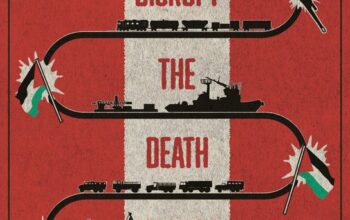Water is not a given, and neither is peace. Since without water, what are we?
“It runs through our veins, bodies, water faucets, and rivers. We are dependent on water; it is a vital element of our survival as much as the air we breathe.” (World Vision, 2021).
Despite this, according to a UN report in 2019 2 billion people live in countries experiencing high water stress and 2.2 billion lack access to safely managed drinking services while over half of the global population lack safely managed sanitation services (UN, 2022). It’s no surprise that when a resource is scarce, insecurities and conflicts follow…
In 2021, the International Crisis Group in their annual ‘ten conflicts to watch’ named Climate Change as an accelerating phenomenon with an increasingly discernible impact on conflict. It was the first time a transnational risk has made the top conflict list, and they described it simply “without urgent action, the danger of climate-related conflict will rise in the years ahead” (Crisis Group, 2021). Water scarcity is one of the key insecurities that will continue to be exacerbated by rising global temperatures and as such, will not only cause more people to flee their homes but increase tensions between governments. Threats from water scarcity often result in ‘water wars’. According to the Pacific Institute’s water conflict chronology, 466 out of 926 conflicts related to water throughout recorded history have occurred in the past decade, while 220 were recorded in the first decade of the millennium (AA, 2020). Most recently, this was seen with the threats of military action between Egypt and Ethiopia over the Grand Ethiopian Dam, due to Egypt’s fears that the dam will exacerbate serious water scarcity (Al-Monitor, 2022). There’s also the relationship between Jordan and Israel over the Dead Sea. Although, there have been tensions regarding water cooperation ever since 1948, it is becoming an increasingly bigger worry due to the Dead Sea shrinking – losing more than a meter of water per year – at an alarming pace. Which has seen tensions continuing to rise (ABC News, 2021). China and India also have a huge need to move into more water diplomacy conversations over Brahmaputra, a conflict-prone river. As Dr Selina Ho writes “the waters of the Himalayas are an invaluable resource for the two countries as rapid economic development and population growth stress their water supplies” (2021). The sad reality is that even without climate change there are growing demands for water resources and so ‘water wars’ are from being over. However, water in conflict goes beyond water scarcity due to climate change. Water can also be used as a weapon of warfare or the target during violent conflicts.
Historically, water has primarily played the role of nourishing life. It has facilitated the growth of agriculture and population, but also acted as a source of inspiration and a reminder as to the beauty of this world. However, in the last few decades, a trend has developed whereby water has been used to destroy rather than nourish societies. This abuse of water as a weapon and target has been seen in this region. Whereby, states and terrorist groups have destroyed water infrastructure in the Middle East. Between the 1960s and 2014, there have been 39 notable water conflicts in the Middle East, occurring within Syria, Iraq, Turkey, Lebanon, Kuwait, Jordan and Kurdistan (SFG, 2014, p.v). The events have been varied and costly. From the Iraqi army burning 730 wells in Kuwait in 1991, to schemes to poison water in Zarqa, Jordan in 2003, and more recently, Islamic State attacking and controlling various dams and water plants in Syria (SFG, 2014, p.v).
The Strategic Foresight Group in 2014 provided a helpful understanding as to what it means when water is treated as a target of violent conflicts or as an instrument of violence. When water is treated as a target of violent conflict, they describe how there is a deliberate effort:
- To damage water and sanitation infrastructure such as natural or manmade water bodies, dams, water treatment plants, supply networks, sewage networks and pipelines.
- To damage supplementary infrastructure such as hydropower plants, electricity cables connected to any water-related activity, roads, bridges, infrastructure in proximity of natural or manmade water bodies.
- To contaminate water using chemicals, bacteria, or any other harmful substance.
- To drain natural and manmade water bodies by cutting off of water supply to those bodies, or filling them up with soil, rocks, cement or other material (SFG, 2014, p.1-2).
When water is used as an instrument of violence, there is a deliberate effort:
- To harm civilians by flooding towns, cutting off water supply to communities, polluting or drying up water bodies, and terminating hydropower supply.
- To ruin the economy by disrupting supplies to irrigation and industrial areas, flooding farms and industrial areas, over exploitation and destruction of water infrastructure.
- To harm political opponents by flooding or drying up key opponent settlements, poisoning their water supplies, destroying their water infrastructure, imposing sanctions.
In both instances, this exploitation and misuse of water not only impacts the environment and those dependent on it, but also causes huge collateral damage. From deterioration of water quality, and loss of water, to producing agricultural losses and in turn, food insecurities.
It’s clear that what we need more than ever, is more “water diplomacy”. Water diplomacy can be defined as the use of diplomatic instruments to existing or emerging disagreements and conflicts over shared water resources with the aim to solve or mitigate those for the sake of cooperation, regional stability, and peace. (Global Water Forum, 2018). Water diplomacy is far more than just water resource management. It has the ultimate goal of ensuring regional cooperation, stability and peace (Global Water Forum, 2018).
Despite water being essential to our everyday lives, it seems rather naïve that our conversations regarding ‘water wars’ and ‘water diplomacy’ are so few.
References
(2020).https://www.aa.com.tr/en/environment/water-increasing-factor-in-global-conflicts/1692788
https://globalwaterforum.org/2018/08/31/what-is-water-diplomacy-and-why-should-you-care/
ABC News. (2021). https://www.abc.net.au/news/2021-06-10/the-disappearing-dead-sea-sinkhole-science-en-gedi/100123858
Al Monitor. (2022).https://www.al-monitor.com/originals/2022/02/egypt-reacts-ethiopia-switches-first-nile-dam-turbine
Crisis Group. (2020).https://www.crisisgroup.org/global/10-conflicts-watch-2021
Ho, S. (2021). https://www.airuniversity.af.edu/Portals/10/JIPA/IndoPacificPerspectives/June%202021/06%20Ho.pdf
Strategic Foresight Group (SFG). (2014).https://www.files.ethz.ch/isn/188318/63948150123-web.pdf
World Vision. (2021). https://www.wvi.org/stories/syria-crisis-response/water-not-given-jordan



